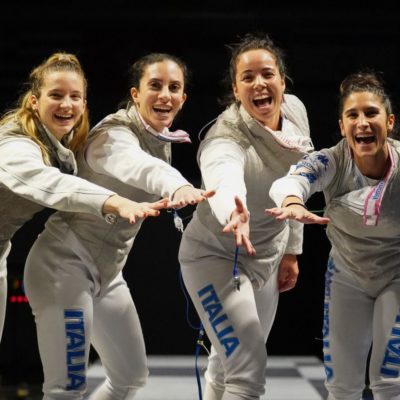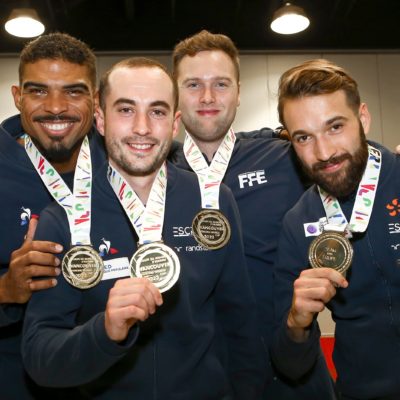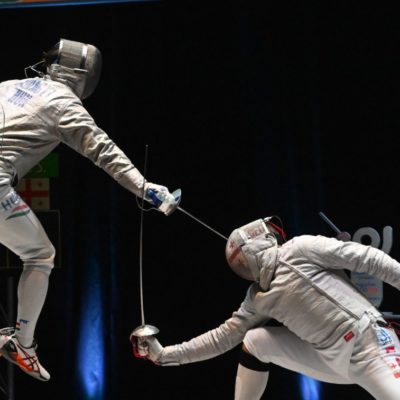{mosimage}3 time Men’s Foil World Champion Sergei Golubitsky takes some time to review the proposed rules changes to foil, where the game is going, and the role of the referee.
Below are questions and answers for May, 2004.
Question: Which fencers inspired you as you were learning? What influences did they bring to your game?
Sergai: My hero was Vladimir Smirnov.He was a member of the same club where I used to train, Kiev’s Sport Army Club. I’ve learned many things,despite that I saw him only once.
I guess the main thing was that you have to work very hard in order to achieve something. Basically the “ghost”, the spirit of Smirnov, was always present in the fencing hall where I used to train as a kid. I was 12 years old when he tragically died. I heard about his working capacity and some other stories. He was the magnet for me for reaching the top. I never tried to copy his style.
Thomas Endres and Alex Koch inspired me to use flicks. Later on I created my own variation of flicking-thrusting movement,which some fencers are using these days (Sanzo,Vanni and some others).
Question: When and how to use the Point in Line
Sergei: You use it against fencers who run to often and too fast. The main uses of point in line:
- To touch your opponent, who is trying to grab your blade, running too fast;
- to stop the opponent and take over ROW
- to let the opponent touch your blade with intention of counter-riposte.
I always tried to use the first option. You can see some of those actions in the Golden Bouts video.
To learn to perform point in line, it is best to start drills during lessons with your coach, then with a partner at pair excercises.
Question: What are Romankov/Endres/Omnes/Gregory/Kim like, as fencers? Strengths and weaknesses?
Sergei:
Romankov,lefthander: the Mozart of fencing. Nature gave him the feeling (gift,talent), which very few (or none) have. I used to train next to him since 1986. From 1989 thru 1992 I fenced with him for the USSR team. He could win creating masterpiece one after another. But,when he got stuck with problem (making counter after counter), very often he couldn’t find the solution to get out of problem. Left the strip at age of 38, when “flickers” were arriving. He was a 10 time World Champion, with many Olympic medals, but never won the Olympics individually.
Endres,righthander: It’s a pity that he had to leave fencing because of a knee injury. It happened at World Champs in The Hague 1995. His last tournament was a World Cup in Portugal, where he took second after Gregory. Thomas was pretty up to tactical game: his favorite thing was fake counter parry-riposte or fake counter and taking over ROW. He was a flick master. That was his strong and the same week spot. Never won a big event individually.
Omnes,lefthander: Classical French school, strong legs, always concentrated, always hungry for victory, never made a flick. He won World Champs in 1990 and Olympic Gold Medal in 1992.
Gregory, righthander: Elvis was the fastest fencer. This is his strength and weakness. Very often his parry-riposte was so incredibly fast, that his blade (which was very flexible) didn’t have time to straighten itself, and therefore arrived flat. He made podiums at the World Champs and Olympics, but never won individually.
Kim, lefthander: Well taught in every aspect of game, strong physically, fast, explosive. From 1996 through 2000 was one of the best around. Lost many times just by 1 touch. In Sydney 2000 won against Bayer, Shevchenko and Bissdorf for the Gold Medal by 1 touch. Made podiums at World Champs and Olympic Champion of Sydney.
{mosimage}Next week we’ll continue with more questions and answers from Sergei including some tips on dealing with Point in Line.
Sergei Golubitsky operates the Golubitsky Fencing Center at: http://www.gfc-world.netfirms.com/.
To submit your question, please send an email to [email protected] with “Ask Sergei” in the subject line.





